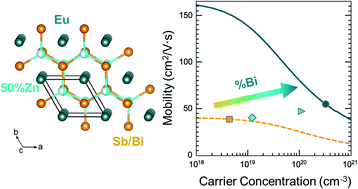Exceptionally high electronic mobility in defect-rich Eu2ZnSb2−xBix alloys†
Abstract
The Zintl compound Eu2ZnSb2 was recently shown to have a promising thermoelectric figure of merit, zT ∼ 1 at 823 K, due to its low lattice thermal conductivity and high electronic mobility. In the current study, we show that further increases to the electronic mobility and simultaneous reductions to the lattice thermal conductivity can be achieved by isovalent alloying with Bi on the Sb site in the Eu2ZnSb2−xBix series (x = 0, 0.25, 1, 2). Upon alloying with Bi, the effective mass decreases and the mobility linearly increases, showing no signs of reduction due to alloy scattering. Analysis of the pair distribution functions obtained from synchrotron X-ray diffraction revealed significant local structural distortions caused by the half-occupied Zn site in this structure type. It is all the more surprising, therefore, to find that Eu2ZnBi2 possesses high electronic mobility (∼100 cm2 V−1 s−1) comparable to that of AM2X2 Zintl compounds. The enormous degree of disorder in this series gives rise to exceptionally low lattice thermal conductivity, which is further reduced by Bi substitution due to the decreased speed of sound. Increasing the Bi content was also found to decrease the band gap while increasing the carrier concentration by two orders of magnitude. Applying a single parabolic band model suggests that Bi-rich compositions of Eu2ZnSb2−xBix have the potential for significantly improved zT; however, further optimization is necessary through reduction of the carrier concentration to realize high zT.



 Please wait while we load your content...
Please wait while we load your content...